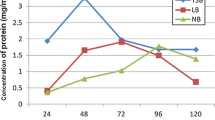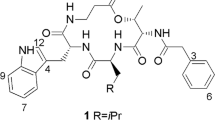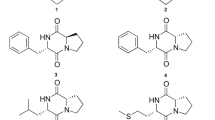Abstract
The cell free culture filtrate of Bacillus cereus associated with an entomopathogenic nematode, Rhabditis (Oscheius) sp. exhibited strong antimicrobial activity. The ethyl acetate extract of the bacterial culture filtrate was purified by silica gel column chromatography to obtain four bioactive compounds. The structure and absolute stereochemistry of these compounds were determined based on extensive spectroscopic analyses (FABMS, 1H NMR, 13C NMR, 1H–1H COSY, 1H–13C HMBC) and Marfey’s method. The compounds were identified as cyclic dipeptides (CDPs): cyclo(l-Pro-l-Trp), cyclo(l-Leu-l-Val), cyclo(d-Pro-d-Met), and cyclo(d-Pro-d-Phe), respectively. Compounds recorded significant antibacterial activity against all the test bacteria (Staphylococcus epidermidis, Staphylococcus aureus, Klebsiella pneumoniae, Escherichia coli, Pseudomonas aeruginosa and methicillin-resistant S. aureus) except cyclo(l-Leu-l-Val). Cyclo(l-Leu-l-Val) recorded activity only against Gram positive bacteria. Best antibacterial activity was recorded by cyclo(l-Pro-l-Trp) against S. aureus (4 μg/ml). The four compounds were active against all the five fungi tested (Trichophyton rubrum, Aspergillus flavus, Candida albicans, Candida tropicalis and Cryptococcus neoformans) and the activity was compared with amphotericin B, the standard fungicide. The highest activity of 1 μg/ml by cyclo(l-Pro-l-Trp) was recorded against T. rubrum, a human pathogen responsible for causing athlete’s foot, jock itch, and ringworm. The activity of cyclo(l-Pro-l-Trp) against T. rubrum, C. neoformans and C. albicans were better than amphotericin B, the standard antifungal agent. To our knowledge, this is the first report of antifungal activity of CDPs against the human pathogenic fungi T. rubrum and C. neoformans. The four CDPs are nontoxic to healthy human cell line up to 200 μg/ml. We conclude that the bacterium associated with entomopathogenic nematode is promising sources of natural antimicrobial secondary metabolites, which may receive greater benefit as potential sources of new drugs in the pharmaceutical industry.





Similar content being viewed by others
References
Akhurst RJ (1982) Antibiotic activity of Xenorhabdus spp., bacteria symbiotically associated with insect pathogenic nematodes of the families Hetrorhabditidae and Steinernematidae. J Gen Microbiol 128:3061–3065
Anteunis MJO (1978) The cyclic dipeptides: proper model compounds in peptide research. Bull Chem Soc Bel 87:627–650
Anto RJ, Venkataraman M, Karunagaran D (2003) Inhibition of NF-KB sensitizes A431 cells to epidermal growth factor-induced apoptosis, whereas its activation by ectopic expression of RelA confers resistance. J Biol Chem 28:25490–25498
Boszormenyi E, Rsek TE, Fodor A, Fodor AM, Szldes FL, Hevesi M, Hogan JS, Katona Z, Klein MG, Kormány A, Pekár S, Szentirmai A, Sztaricskai F, Taylor RAJ (2009) Isolation and activity of Xenorhabdus antimicrobial compounds against the plant pathogens Erwinia amylovora and Phytophthora nicotianae. J Appl Microbiol 107:746–759
Cheenpracha S, Borris RP, Tran TT, Jee J, Seow HF, Cheah HY, Hoc CC, Chang LC (2011) Three new amides from Streptomyces sp. H7372. J Braz Chem Soc 22(2):223–229
Chen G, Dunphy GB, Webster JM (1994) Antifungal activity of two Xenorhabdus species and Photorhabdus luminescens, bacteria associated with the nematodes Steinernema species and Heterorhabditis megidis. Biol Control 4:157–162
Chen G, Maxwell P, Dunphy GB, Webster JM (1996) Culture conditions for Xenorhabdus and Photorhabdus symbionts of entomopathogenic nematodes. Nematologica 42:124–127
CLSI (Clinical and Laboratory Standards Institute) (2006) Methods for dilution antimicrobial susceptibility tests for bacteria that grow aerobically. CLSI documents M27-S3. 940 West Valley Road, Suite 1400, Wayne, Pennsylvania 19087-1898 USA
CLSI (Clinical and Laboratory Standards Institute) (2008) Reference methods for broth dilution antifungal susceptibility tests of yeasts. CLSI documents M27-S3. 940 West Valley Road, Suite 1400, Wayne, Pennsylvania 19087-1898 USA
De Rosa S, Mitova M, Tommonaro G (2003) Marine bacteria associated with sponge as source of cyclic peptides. Biomol Eng 20:311–316
Deepa I, Mohandas C, Makesh KT, Siji JV, Prakash KBS, Babu B (2010) Identification of new entomopathogenic nematodes (EPNs) based on sequences of D2–D3 expansion fragments of the 28SrRNA. J Root Crops 36(2):227–232
Degrassi G, Aguilar C, Bosco M, Zahariev S, Pongor S, Venturi V (2002) Plant growth-promoting Pseudomonas putida WCS358 produces and secrets four cyclic dipeptides: cross-talk with quorum sensing bacterial sensors. Curr Microbiol 45:250–254
Fdhila F, Vazquez V, Sanchez JL, Riguera R (2003) DD-diketopiperazines: antibiotics active against Vibrio anguillarum isolated from marine bacteria associated with cultures of Pecten maximus. J Nat Prod 66:1299–1301
Forst S, Nealson KH (1996) Molecular biology of the symbiotic–pathogenic bacteria Xenorhabdus spp. and Photorhabdus spp. Microbiol Rev 60:21–43
Forst S, Dowds B, Boemare N, Stackebrandt E (1997) Xenorhabdus and Photorhabdus spp. bugs that kill bugs. Annu Rev Microbiol 51:47–72
Gaugler R, Kaya HK (1990) Entomopathogenic nematodes in biological control. CRC Press, Boca Raton, pp 75–90
Graz M, Hunt A, Jamie H, Grant G, Milne P (1999) Antimicrobial activity of selected cyclic dipeptides. Pharmazie 54:772–775
Gualtieri M, Aumelasm A, Thaler JO (2009) Identification of a new antimicrobial lysine-rich cyclolipopeptide family from Xenorhabdus nematophila. J Antibiot 62:295–302
Holden MTG, Chhabra SR, de Nys R, Stead P, Bainton NJ, Hill PJ, Manefield M, Kumar N, Labatte M, England D, Rice S, Givskov M, Salmond GPC, Stewart GSAB, Bycroft BW, Kjelleberg SA, Williams P (1999) Quorem-sensing cross talk: isolation and chemical characterization of cyclic dipeptides from Pseudomonas aeruginosa and other gram negative bacteria. Mol Microbiol 33:1254
Houston DR, Synstad B, Eijsink VG, Stark MJ, Eggleston IM, van Aalten DM (2004) Structure-based exploration of cyclic dipeptide chitinase inhibitors. J Med Chem 47:5713–5720
Jayatilake GS, Thornton MP, Leonard AC, Grimwade JE, Baker BJ (1996) Metabolites from an Antarctic sponge-associated bacterium, Pseudomonas aeruginosa. J Nat Prod 59:293–296
Ji DJ, Yi YK, Kang GH (2004) Identification of an antibacterial compound, benzylideneacetone, from Xenorhabdus nematophila against major plant-pathogenic bacteria. FEMS Microbiol Lett 239:241–248
Lang G, Kalvelage T, Peters A, Wiese J, Imhoff JF (2008) Peptides from the entomopathogenic bacterium Xenorhabdus nematophilus. J Nat Prod 71:1074–1077
Li J, Chen GH, Wu HM, Webster JM (1995) Identification of two pigments and a hydroxystilbene antibiotic from Photorhabdus luminescens. Appl Environ Microbiol 61:4329–4333
Li JX, Chen GH, Webster JM (1997) Nematophin, a novel antimicrobial substance produced by Xenorhabdus nematophilus (Enterobactereaceae). Can J Microbiol 43:770–773
Li X, Dobretsov S, Xu Y, Xiao X, Hung S, Qian PY (2006) Antifouling diketopiperazines produced by a deep-sea bacterium, Streptomyces fungicidicus. Biofouling 22(3):187–194
Long C, Lu XL, Gao Y, Jiao BH, Liu XY (2011) Description of a Sulfitobacter strain and its extracellular cyclodipeptides. Evidence-Based Complement Altern Med 1–6. doi:10.1155/2011/393752
Marfey P (1984) Determination of d-amino acids. II. Use of a bifunctional reagents, 1,5-difluoro-2,4-dinitrobenzene. Carlsberg Res Commun 49:591–596
Martins MB, Carvalho I (2007) Diketopiperazines: biological activity and synthesis. Tetrahedron 63:9923–9932
McInerney BV, Gregson RP, Lacey MJ, Akhurst RJ, Lyons GR, Rhodes SH, Smith DRJ, Engelhardt LM (1991a) Biologically active metabolites from Xenorhabdus spp. Part 1. Dithiolopyrrolone derivatives with antibiotic activity. J Nat Prod 54:774–784
McInerney BV, Taylor WC, Lacey MJ, Akhurst RJ, Gregson RP (1991b) Biologically active metabolites from Xenorhabdus spp. Part 2 Benzopyran-1-one derivatives with gastroprotective activity. J Nat Prod 54:785–795
Mohandas C, Sheeba M, Firoza AJ, Rajamma P (2007) Bacteria associated with Rhabditis (Oscheius) spp. (Rhabditidae: Nematoda) for the biocontrol of insect pests. In: Proceedings of national seminar on achievements and opportunities in post harvest management and value addition in root and tuber crops (NSRTC—2), pp 195–198
Murray PR, Baron EJ, Pfaller MA, Tenover FC, Yolke RH (1995) Manual clinic microbiol, vol 6. ASM, Washington
Nicholson B, Lloyd GK, Miller BR, Palladino MA, Kiso Y, Hayashi Y, Neuteboom ST (2006) NPI-2358 is a tubulin-depolymerizing agent: in vitro evidence for activity as a tumor vascular-disrupting agent. Anticancer Drugs 17:25–31
Paul VJ, Frautschy S, Fenical W, Nealson KH (1981) Antibiotics in microbial ecology, isolation and structure assignment of several new antibacterial compounds from the insect symbiotic bacteria Xenorhabdus spp. J Chem Ecol 7:589–597
Prasad C (1995) Bioactive cyclic dipeptides. Peptides 16:151–164
Rhee KH (2004) Cyclic dipeptides exhibit synergistic, broad spectrum antimicrobial effects and have anti-mutagenic properties. In J Antimicrob Agents 24:423–427
Rhee KH (2006) In vitro activity of cyclic dipeptides against gram-positive and gram-negative anaerobic bacteria and radioprotective effect on lung cells. J Microbiol Biotechnol 16(1):158–162
Rollas S, Kalyoncuoglu N, Sur-Altiner D, Yegenglu Y (1993) 5-(4-aminophenyl)-4-substituted 2,4-dihydro-3H-1,2,4-triazole-3-thiones: synthesis, antibacterial and antifungal activities. Pharmazie 48:308–309
Rudi A, Kashman Y, Benayahu Y, Schleyer M (1994) Amino acid derivatives from the marine sponge Jaspis digonoxea. J Nat Prod 57:829
Shin HJ, Mojid Mondol MA, Yu TK, Lee HS, Lee YJ, Jin HJ, Kim JH, Kwon HJ (2010) An angiogenesis inhibitor isolated from a marine-derived actinomycete, Nocardiopsis sp. 03N67. Phytochem Lett 3:194–197
Smith-Palmer A, Stewart J, Fyfe L (1998) Antimicrobial properties of plant essential oils and essences against five important food-borne pathogens. Lett Appl Microbiol 26:118–122
Song MK, Hwang IK, Rosenthal MJ, Harris DM, Yamaguchi DT, Yip I, Go VLW (2003) Anti-hyperglycemic activity of zinc plus cyclo(His-Pro) in genetically diabetic goto-kakizaki and aged rats. Exp Biol Med 228:1338–1345
Strom K, Sjogren J, Broberg A, Schnurer J (2002) Lactobacillus plantarum MiLAB 393 produces the antifungal cyclic dipeptides cyclo(l-Phe-l-Pro) and cyclo(l-Phe-trans-4-OH-l-pro) and 3-phenyllactic acid. Appl Environ Microbiol 68:4322–4327
Tailliez P, Laroui C, Ginibre N, Paule A, Page S, Boemare N (2010) Phylogeny of Photorhabdus and Xenorhabdus based on universally conserved protein-coding sequences and implications for the taxonomy of these two genera. Proposal of new taxa: X. vietnamensis sp. nov., P. luminescens subsp. Caribbeanensis subsp. nov., P. luminescens subsp. hainanensis subsp. nov., P. temperata subsp. Khanii subsp. nov., P. temperata subsp. Tasmaniensis subsp. nov., and the reclassification of P. luminescens subsp. thracensis as P. temperate subsp. thracensis comb. nov. Syst Evol Microbiol 60:1921–1937
van der Merwe E, Huang D, Peterson D, Kilian G, Milne PJ, Van de Venter M, Frost C (2008) The synthesis and anticancer activity of selected diketopiperazines. Peptides 29:1305–1311
Wang Y, Mueller UG, Clardy J (1999) Antifungal diketopiperazines from symbiotic fungus of fungus-growing ant Cyphomyrmex minutus. J Chem Ecol 25(4):245–257
Wang G, Dai S, Chen M, Wu H, Lianwu X, Xiongming L, Li Z (2010) Two diketopiperazine cyclo(Pro-Phe) isomers from marine bacteria Bacillus subtilis sp. 13-2. Chem Nat Compd 46(4):583–585
Acknowledgments
The authors are grateful to Indian Council Medical Research (ICMR), Government of India for funding. We thank the Director, CTCRI, for providing facilities for the work.
Author information
Authors and Affiliations
Corresponding author
Electronic supplementary material
Below is the link to the electronic supplementary material.
Rights and permissions
About this article
Cite this article
Nishanth Kumar, S., Nath, V.S., Pratap Chandran, R. et al. Cyclic dipeptides from rhabditid entomopathogenic nematode-associated Bacillus cereus have antimicrobial activities. World J Microbiol Biotechnol 30, 439–449 (2014). https://doi.org/10.1007/s11274-013-1461-7
Received:
Accepted:
Published:
Issue Date:
DOI: https://doi.org/10.1007/s11274-013-1461-7




